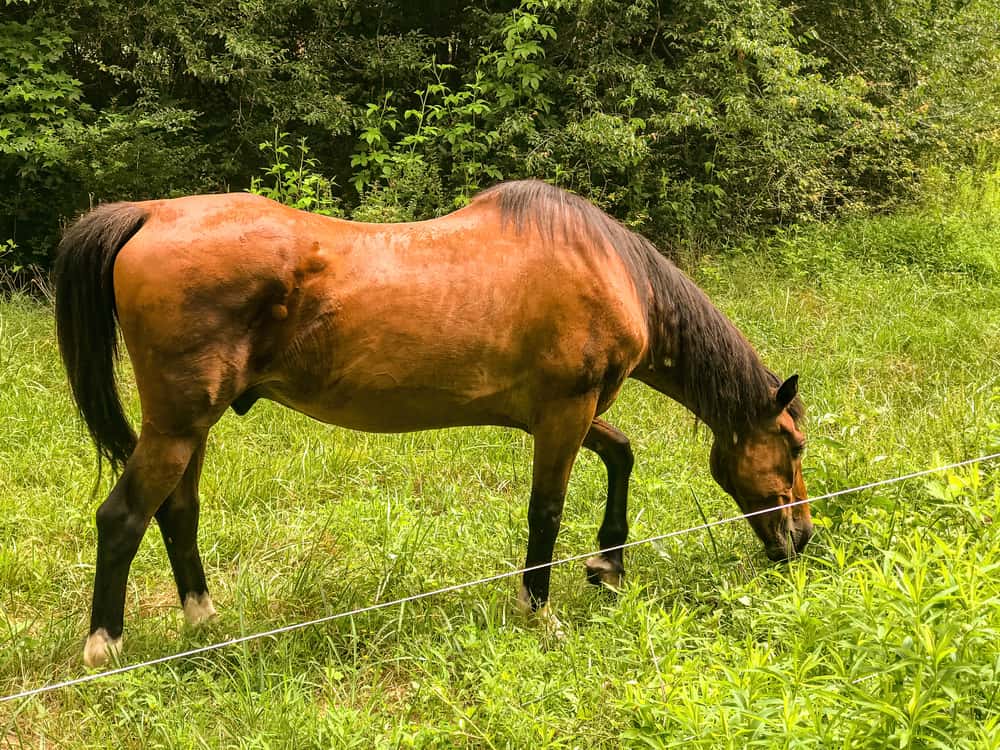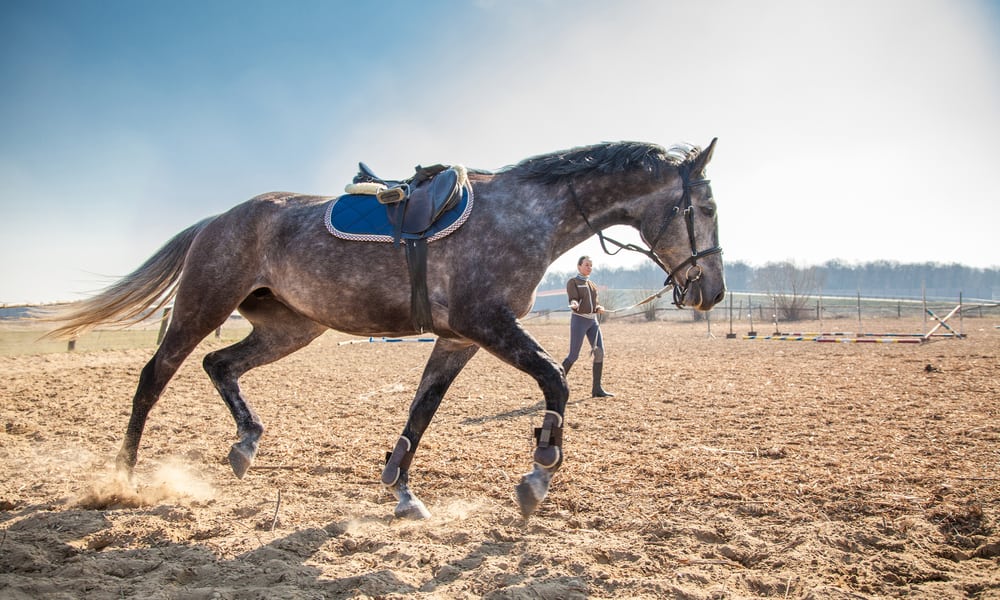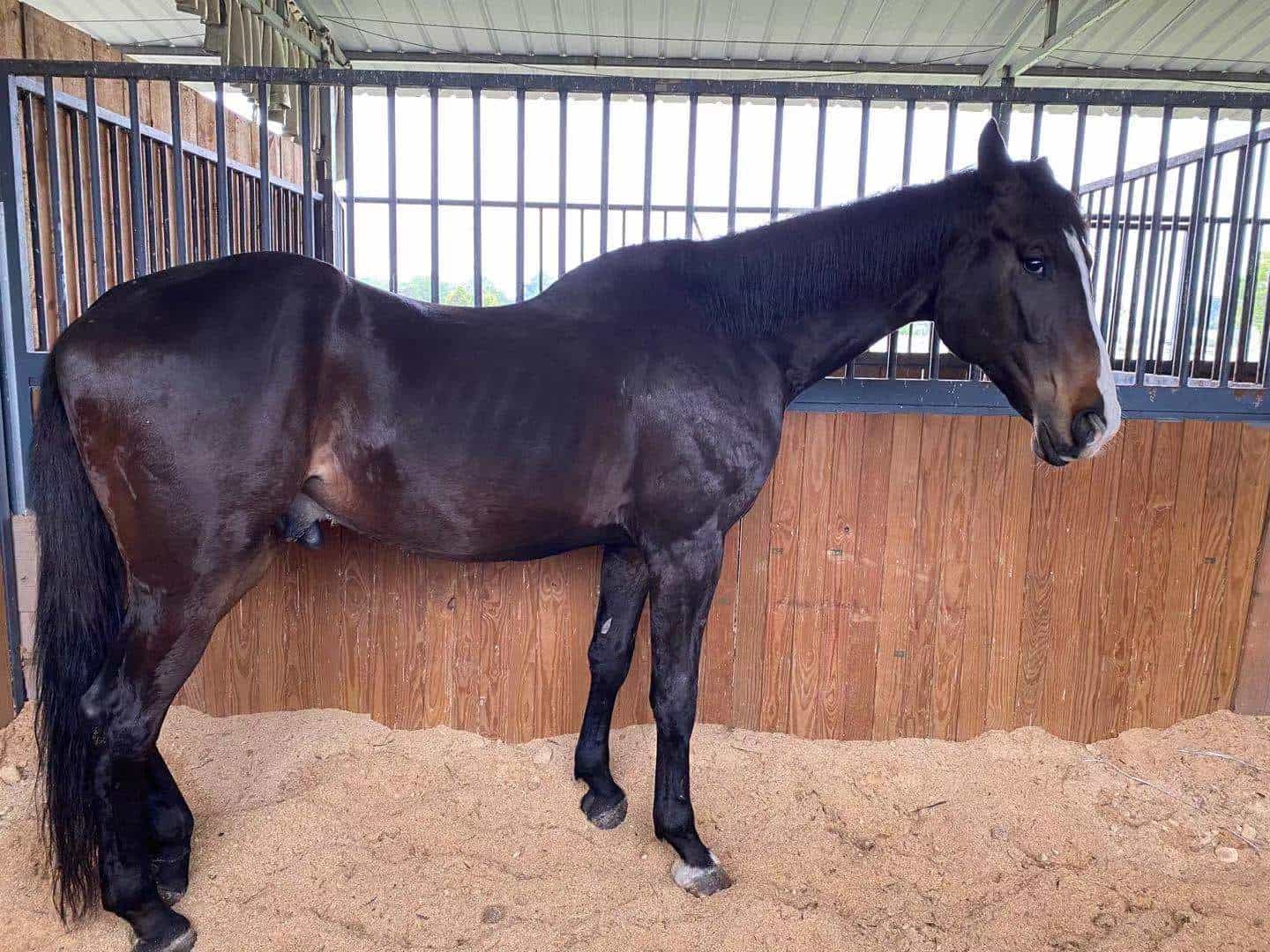The swayback condition on a horse may be due to its genetic disposition, old age, or some other injury-induced spinal malformation.
Although there may not be a way to reverse the condition, experts believe that horse owners can do some things to improve a horse’s strength and comfort levels.
This article aims to inform you of the various causes of a swayed back on a horse, appropriate care practices to help prevent the situation, and different post-trauma therapy to implement if your horse suffers from this condition.
What Is Sway Back On A Horse?
As vertebrates, humans have a natural curve to our spine to support the weight of our heads and neck, absorb shock, and promote flexibility. Similarly, horses also have a natural curve to their spine to help maintain and support their structure.
When a horse’s spine curves too far inward, the condition results in lordosis or more commonly referred to as swayback in the equine world. There are several reasons for the occurrence of this condition.
Before I discuss the various causes of the swayback condition, let us investigate further what is happening to cause the malformation in the horse’s spinal structure.
Swayback is the weakening of spinal tissue, which results in the inward curvature of the spinal cord. With the added weight of the horse’s abdomen pulling downward, the condition is progressive.
A swayed back is most commonly associated with older horses. And though this condition presents itself in broodmares because they have carried and delivered several large loads, it is usually onset in the later stages of a horse’s life.
There is a juvenile presentation of swayback that occurs because of an early malformation to the spinal column. However, it is by far much less common to see the earlier onset of this condition.
The swayback trait may also be “found in some horses with American Saddlebred bloodlines.” Regarding the genetic disposition of some breeds to this condition, scientists have more research to conduct.
Back injury in horses needs further investigation on the whole. However, regardless of this, use-caused damage is possible, and carrying a heavy rider or equipment for many years might increase the risk of a swayback.
But My Horse Was Not Born That Way.
Even if your horse was not born with a swayed back, it is your responsibility to encourage healthy habits and employ good riding techniques. Regular exercise throughout the life of your horse is vital in keeping its muscles limber and toned.
A horse’s back may suffer from unnecessary pressure and soreness by improper training, poor riding techniques, and improper saddle fit. And whether you realize it or not, a horse needs just as much training to carry a person as a person needs the practice to ride the horse.
Saddle fit is an essential investment into your horse’s health and deserves the attention of a sizing professional for proper fitment. If the saddle does not fit properly, it can cause undue pain and nerve deadening to your horse’s vertebral column.
As a rider, you will benefit significantly from professional instruction to remove lousy riding habits that may adversely affect your horse. For example, when carrying you on its back, your horse must be engaging its hindquarters instead of relying on just its forehands for healthy spinal health and smooth gait.
The horse that you ride should be proportional to your current weight and height measurements. If you bounce around in the saddle, you are releasing repetitive shock to your horse’s spine, which you need to avoid at all costs.
How Can I Help Strengthen A Horse With Swayback?
For a horse that suffers from a swayed back, there are some things that horse owners can do to help strengthen and support their horse.
And though, unfortunately, medical doctors cannot reverse the condition, equestrian experts offer some excellent tips and advice on how to care for a horse with swayback properly.
Before you decide to engage your horse with any particular therapy, please consult with your veterinarian and possibly seek an equine chiropractor. The various stretching techniques should promote your horse to lift and round its back, which requires abdominal strength and control.
Swayback can be an unsightly condition that can affect the intended job of your horse. Be careful not to allow your horse to fall to inactivity. Although your horse may not exhibit pain or discomfort, you should be watchful for signs of lameness.
Whether swayback affects or reduces your horse’s quality of life may need concurring observation, you should remain proactive in your horse’s care and training regimen.
Some specific tips and advice that some equine experts have recommended include:
- Cavalletti work aims at promoting year-round health and agility to horses. Cavaletti training loosens back muscles and naturally strengthens muscle tone through various stretching techniques.
- Invest in properly fitting equipment, as I already mentioned.
- Longeing, when used safely, can be an excellent rehabilitative tool for horses that suffer from swayback or even arthritis. This training technique is riderless, and when performed correctly, it should cause your horse to stretch its legs, round its back (pulling the vertebra), and even strengthen its abdominal cavity.
- You can employ another riderless technique known as ground driving to help coerce your horse into lifting its back, which will help tone and strengthen its abdominal muscles.
- Implement carrot stretches into your horse’s routine. These dynamic exercises encourage your horse to express various degrees of mobility. The combination of stretching and relaxing different targeted muscles can show quite an improvement in flexibility over time.
Horse owners and professionals worldwide must understand the importance of their horse’s health and should take the time to explore various techniques and therapies available to promote its comfort and happiness.
As a horse owner, you may have already heard about the benefits of infrared technology circulating the equine community. It’s true, the effects of infrared emitting technology are gaining significant notoriety throughout the medical industry.
For instance, the Benefab Rejuvenate Smartscrim is a blanket-type sheet that emits infrared technology to specific acupuncture points on a horse to improve circulation and promote pain relief.
The mesh fabric blanket is just one infrared emitting product that exists in the equine world to help relax and soothe your horse’s muscles. The reviews of this particular product may blow you away if you have a horse that suffers from a swayed back.
Can My Horse Continue to Function With Swayback?
Often, an older horse that has developed swayback later in life will continue to live out its days without significantly affecting its lifestyle. However, in a younger horse, swayback may prevent a horse from performing its intended job, although the condition itself may not necessarily progress.
Depending on your horse’s lordosis severity, you may have to reconsider the job you originally intended for it. In addition, its overall performance potential may limit it from higher levels of competition.
I hope you agree that your horse’s overall health and happiness are more critical than shows and competitions. Unfortunately, the truth is that while some horses may not suffer much, others may not be able to support any riding or lifting activities at all due to the amount of pain and discomfort caused to their back.
Your veterinarian may clear a horse with a milder form of swayback to continue giving short rides to younger children. If you are the owner of a horse breed with an anatomically longer back, you could even look into acquiring unique tack such as the Kavallerie Gel Saddle Pad.
This ergonomic pad comes in four specific configurations to prevent uneven distribution to their back, soreness, and other irritations. In addition, half-pads and complete dress solutions are readily available on the equine marketplace to help horses with various spinal conditions.
Still, before purchasing one of these over-the-counter devices, you should first consult with your trusted veterinarian for their expert approval.
For horses with a genetic disposition to the swayback condition, it is essential to note that scientists have found that the marker does not affect all horses that carry the genetic trait.
Furthermore, both parents would have to carry the genetic trait to pass it on to their offspring. Even this may not guarantee that the foul will be born with a swayback, but as a breeder, you could do your part in eliminating the risk by deciding not to pair a stallion and broodmare that both carry the trait.
Conclusion
A horse with a swayed back may grow into its condition obliviously or become more noticeably restricted. In either case, do not despair because you are a wonderful horse owner and can continue to provide loving care to your horse, allowing it to live a whole and happy life.
If your horse is diagnosed with lordosis, do not hesitate to contact an equine chiropractor or massage professional for advice on incorporating various strategies to help your horse cope with its condition.
Please share your comments or questions about horses with a sway back in the comment section below.










